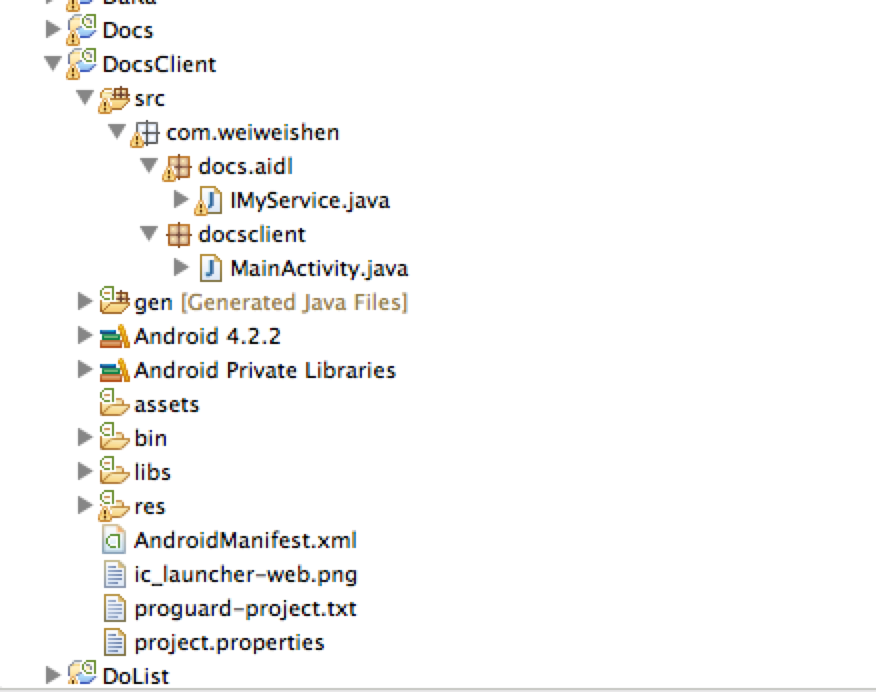
我相信稍微对android了解一点的人都知道Android系统进程之间是不能共享内存的。因此,需要一些机制来实现不同进程之间的数据交互。Android系统采用RPC方法来实现,实现RPC的服务我们称之为AIDL服务(Android Interface Definition Language)服务。
在这里我们将提供服务的一个应用程序称之为服务端,接受服务的一方叫做客户端。你首先得在服务端定义一个aidl文件,如下所示:
// IMyService.aidlpackage com.weiweishen.docs.aidl;interface IMyService{String getValue();} 然后重新编译程序,系统会在gen目录自动生成一个IMyService.java文件,你不需要改动它,源代码如下:
//IMyService.java/* * This file is auto-generated. DO NOT MODIFY. * Original file: /Users/wei/Documents/work/Docs/src/com/weiweishen/docs/aidl/IMyService.aidl */package com.weiweishen.docs.aidl;public interface IMyService extends android.os.IInterface{/** Local-side IPC implementation stub class. */public static abstract class Stub extends android.os.Binder implements com.weiweishen.docs.aidl.IMyService{private static final java.lang.String DESCRIPTOR = "com.weiweishen.docs.aidl.IMyService";/** Construct the stub at attach it to the interface. */public Stub(){this.attachInterface(this, DESCRIPTOR);}/** * Cast an IBinder object into an com.weiweishen.docs.aidl.IMyService interface, * generating a proxy if needed. */public static com.weiweishen.docs.aidl.IMyService asInterface(android.os.IBinder obj){if ((obj==null)) {return null;}android.os.IInterface iin = obj.queryLocalInterface(DESCRIPTOR);if (((iin!=null)&&(iin instanceof com.weiweishen.docs.aidl.IMyService))) {return ((com.weiweishen.docs.aidl.IMyService)iin);}return new com.weiweishen.docs.aidl.IMyService.Stub.Proxy(obj);}@Override public android.os.IBinder asBinder(){return this;}@Override public boolean onTransact(int code, android.os.Parcel data, android.os.Parcel reply, int flags) throws android.os.RemoteException{switch (code){case INTERFACE_TRANSACTION:{reply.writeString(DESCRIPTOR);return true;}case TRANSACTION_getValue:{data.enforceInterface(DESCRIPTOR);java.lang.String _result = this.getValue();reply.writeNoException();reply.writeString(_result);return true;}}return super.onTransact(code, data, reply, flags);}private static class Proxy implements com.weiweishen.docs.aidl.IMyService{private android.os.IBinder mRemote;Proxy(android.os.IBinder remote){mRemote = remote;}@Override public android.os.IBinder asBinder(){return mRemote;}public java.lang.String getInterfaceDescriptor(){return DESCRIPTOR;}@Override public java.lang.String getValue() throws android.os.RemoteException{android.os.Parcel _data = android.os.Parcel.obtain();android.os.Parcel _reply = android.os.Parcel.obtain();java.lang.String _result;try {_data.writeInterfaceToken(DESCRIPTOR);mRemote.transact(Stub.TRANSACTION_getValue, _data, _reply, 0);_reply.readException();_result = _reply.readString();}finally {_reply.recycle();_data.recycle();}return _result;}}static final int TRANSACTION_getValue = (android.os.IBinder.FIRST_CALL_TRANSACTION + 0);}public java.lang.String getValue() throws android.os.RemoteException;} 这个步骤完成之后,你就可以通过继承IMyService.Stub(继承自Binder类,Android本质上利用Binder实现进程之间的交互)来实现提供服务的具体方法。
//IMyService.javapackage com.weiweishen.docs;import android.app.Service;import android.content.Intent;import android.os.IBinder;import android.os.RemoteException;import com.weiweishen.docs.aidl.IMyService;;public class MyService extends Service { int i = 1; public MyService() { } public class MyServiceImpl extends IMyService.Stub{ @Override public String getValue() throws RemoteException { // TODO Auto-generated method stub i ++ ; return "hello everyone " + i; } } @Override public IBinder onBind(Intent intent) { return new MyServiceImpl(); }} 我们看上面代码,MyServiceImpl继承了IMyService.Stub。getValue()方法是我们提供给客户端的服务,在这里我们是返回一个字符串给客户端。onBinder方法返回一个Binder类,即我们继承IMyService.stub的MyServiceImpl的内部类。实现了这一步,我们服务器端的代码就写好了,下面我们看看客户端,另建一个android project,将IMyService文件连同包目录拷贝到客户端工程的src目录中,看下图,然后在MainActivity实现跨进程调用。

下面是MainActivity的代码:
//MainActivity.javapackage com.weiweishen.docsclient;import com.weiweishen.docs.aidl.IMyService;import android.app.Activity;import android.content.ComponentName;import android.content.Context;import android.content.Intent;import android.content.ServiceConnection;import android.os.Bundle;import android.os.IBinder;import android.os.RemoteException;import android.view.Menu;import android.view.MenuItem;import android.view.View;import android.view.View.OnClickListener;import android.widget.Button;import android.widget.Toast;public class MainActivity extends Activity implements OnClickListener{ IMyService myService = null; Button btn1; Button btn2; Button btn3; @Override protected void onCreate(Bundle savedInstanceState) { super.onCreate(savedInstanceState); setContentView(R.layout.activity_main); btn1 = (Button)findViewById(R.id.button1); btn2 =(Button)findViewById(R.id.button2); btn3 =(Button)findViewById(R.id.button3); btn1.setOnClickListener(this); btn2.setOnClickListener(this); btn3.setOnClickListener(this); } private ServiceConnection serviceConnection = new ServiceConnection() { @Override public void onServiceDisconnected(ComponentName name) { // TODO Auto-generated method stub } @Override public void onServiceConnected(ComponentName name, IBinder service) { // TODO Auto-generated method stub myService = IMyService.Stub.asInterface(service); } }; @Override public boolean onCreateOptionsMenu(Menu menu) { // Inflate the menu; this adds items to the action bar if it is present. getMenuInflater().inflate(R.menu.main, menu); return true; } @Override public boolean onOptionsItemSelected(MenuItem item) { // Handle action bar item clicks here. The action bar will // automatically handle clicks on the Home/Up button, so long // as you specify a parent activity in AndroidManifest.xml. int id = item.getItemId(); if (id == R.id.action_settings) { return true; } return super.onOptionsItemSelected(item); } @Override public void onClick(View v) { // TODO Auto-generated method stub switch (v.getId()) { case R.id.button1: bindService(new Intent("com.weiweishen.docs.aidl.IMyService"), serviceConnection, Context.BIND_AUTO_CREATE); break; case R.id.button2: try { Toast.makeText(MainActivity.this, myService.getValue(), Toast.LENGTH_LONG).show(); } catch (RemoteException e) { // TODO Auto-generated catch block e.printStackTrace(); } break; case R.id.button3: unbindService(serviceConnection); break; default: break; } }} 这里值得注意的是,服务器端的service必须是开启的,否则会报错。这里,按钮1开启服务,按钮2显示返回的数据,按钮3结束服务。
AIDL的介绍就到这里了,感觉自己对Binder的原理理解还是不太透彻,如果有什么不足,欢迎指正。